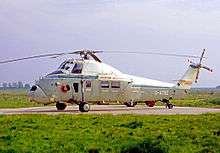1981 Bristow Helicopters Westland Wessex crash
 A Bristow Westland Wessex 60 of the same type as G-ASWI | |
| Accident summary | |
|---|---|
| Date | 13 August 1981 |
| Summary | Loss of power |
| Site |
near 12 miles ENE of Bacton, Norfolk in the North Sea 52°56′N 1°46′E / 52.933°N 1.767°ECoordinates: 52°56′N 1°46′E / 52.933°N 1.767°E |
| Passengers | 11 |
| Crew | 2 |
| Fatalities | 13 (all) |
| Aircraft type | Westland Wessex |
| Operator | Bristow |
| Registration | G-ASWI |
G-ASWI was a Westland Wessex 60, operated by Bristow Helicopters operating between Bacton Gas Terminal, in Norfolk, and gas rigs in the North Sea. On 13 August 1981 the helicopter lost power to the main rotor gearbox, going out of control during the ensuing autorotation. The flight was carrying 11 gas workers from the Leman gas field to Bacton. All people on board were lost.
Aircraft
G-ASWI had previously been the Westland Helicopters Company demonstrator[1][2] before being purchased by Bristow Helicopters Ltd. in April 1970.[3]
Accident and outcomes
G-ASWI left the North Denes airfield at 13:47 on Friday 13 August 1981 on a routine passenger and freight flight between rigs on the Leman and Indefatigable gas fields. The crew consisted of a pilot and a cabin attendant.
At 15:41, returning from the Leman field to the landing site at Bacton, the commander, Ben Breach,[4] sent a distress message reporting that he was ditching due to engine failure. Radar lost the aircraft three seconds later. A Royal Air Force Search and Rescue Westland Sea King left RAF Coltishall at 15:47, sighting floating wreckage from G-ASWI at 15:57. There were no survivors.
Efforts to recover the wreck were delayed, meaning that the wreck was beyond recovery by the time salvage operations started.[5] There was insufficient evidence to explain either the loss of power or loss of control that caused the aircraft to crash.[6][7] The inquest into the deaths of those on board recorded an open verdict.[8][9]
Memorial
On August 13th 2014 a memorial to those killed in the crash was unveiled at Great Yarmouth Minster.[10] A major article on the ongoing effects of the crash was published in the Eastern Daily Press in September 2014.[11]
References
- Report No: 4/1983. Report on the accident to Westland Wessex 60, G-ASWI, 12 miles ENE of Bacton, Norfolk on 13 August 1981
- 4/1983 Westland Wessex 60, G-ASWI Appendices
- ↑ "Photograph of G-ASWI as Westland demonstrator aircraft". Airliners.net. 20 September 1968. Retrieved 16 May 2011.
- ↑ "Photograph of G-ASWI in modified AMOCO livery". Airliners.net. 18 May 2003. Retrieved 16 May 2011.
- ↑ "G-ASWI registration record" (PDF). Retrieved 16 May 2011.
- ↑ "Wessex Crash, Norfolk 1981 (archive)". Pprune.org. 13 August 1981. Retrieved 16 May 2011.
- ↑ "Crash Investigators' arduous task, BBC, 2002". BBC News. 18 July 2002. Retrieved 16 May 2011.
- ↑ "Flightglobal Archive 1". Flight International. Retrieved 16 May 2011.
- ↑ "(posts 287, 288)". PPRuNe. Retrieved 16 May 2011.
- ↑ "Flightglobal Archive 2". Flight International. 5 December 1981. Retrieved 16 May 2011.
- ↑ "Flightglobal Archive 3". Flight International. Retrieved 16 May 2011.
- ↑ Memorial stone is unveiled to commemorate helicopter tragedy that ended the life of eight people from Norfolk
- ↑ Helicopter crash left families without fathers, sons, brothers and husbands.